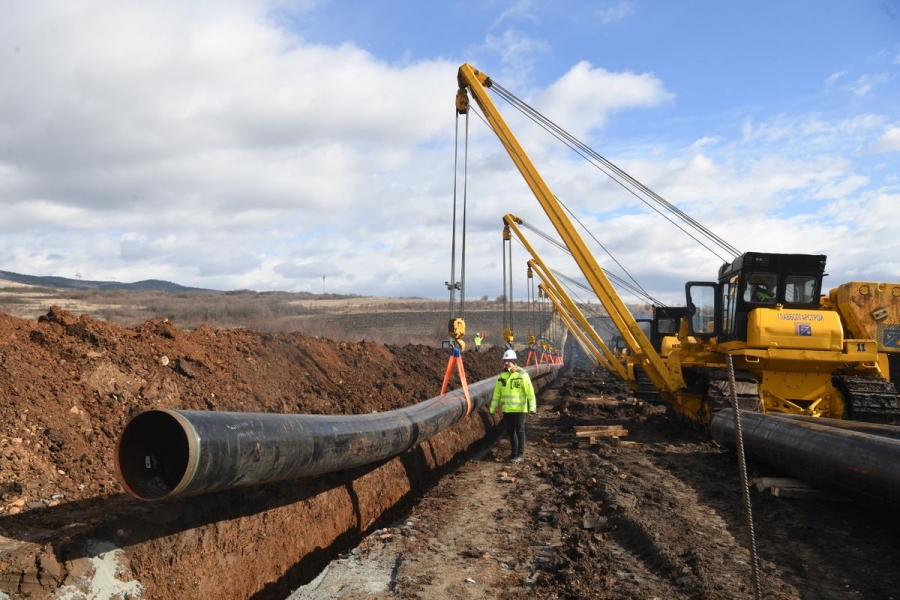Physical works on the construction of the Serbia - Bulgaria gas interconnector, which should enable diversification of supply sources, will be completed in early November, while the issuance of permits and the start of work are expected a few weeks after that, Demostat was told by the Ministry of Mining and Energy.

Physical works on the construction of the Serbia - Bulgaria gas interconnector, which should enable diversification of supply sources, will be completed in early November, while the issuance of permits and the start of work are expected a few weeks after that, Demostat was told by the Ministry of Mining and Energy.

The Memorandum of understanding between the ministries of energy of Serbia and Azerbaijan, as well as the commercial contract of the Azerbaijani supplier and JP Srbijagas, is expected to be signed by the end of November.
It is said that negotiations are ongoing with the company of Azerbaijan about supplies. The Ministry also states that Srbijagas is in the phase of leasing part of the LNG terminal in Alexandroupolis on a long-term basis.
”It is planned to lease about 300 million cubic meters annually when the terminal starts operating”, the Ministry said.
The Ministry said the supply of natural gas through the interconnector is expected to begin by the end of this year.
The construction of the Serbia-Bulgaria gas interconnector should enable diversification of supply sources, greater energy stability and free Serbia and the region from dependence on Russian gas.
Minister of Mining and Energy Dubravka Djedovic Handanovic announced at the end of September that the Serbia - Bulgaria gas interconnector will be built in October, stating that it is of strategic interest to the European Union as Serbia will thus become a transit country for gas supply to the EU.
The gas interconnector is crucial for energy diversification in Serbia, as the state will get the infrastructure through which it will be able to supply gas from various sources.
The Ministry of Mining and Energy told Demostat in March that talks were underway with partners from Azerbaijan on the amount and prices of gas, "which Serbia could receive from next year", while the Director General of Srbijagas, Dusan Bajatovic, said in mid-March that Serbia had already reserved 300 million cubic meters of gas in the LNG terminal for liquefied natural gas in the Greek port of Alexandroupolis.
With the completion of the Serbia-Bulgaria gas interconnection, Serbia will be given the opportunity to connect with gas sources reaching Greece, including gas from Azerbaijan and the Caspian region and LNG terminals in Greece.
When it comes to liquefied natural gas, the LNG terminal in Alexandroupolis, Greece, can receive gas from all over the world, so the suppliers could be Qatar, Norway or US companies.
The gas interconnector should change the energy picture of the entire region, which is heavily dependent on Russian gas.
The Serbia-Bulgaria gas interconnection is part of a wider EU initiative, the Southern Gas Corridor, aimed at reducing Europes dependence on Russian gas.
The aim of the European Union is energy diversification, especially after the war in Ukraine started, which is why some EU countries have freed themselves from dependence on Russian gas or are on track to do so.
The EU is helping both Serbia and the region to diversify their sources of gas supply.
This is why we support the construction of the Serbia -Bulgaria interconnector.
The EU has allocated EUR 49.6 million in grants for Serbia through IPA funds for the gas interconnector project, whose total value is EUR 85.5 million. Bulgaria also received a grant of 27.6 million euros for the construction of the gas pipeline on its territory.
The rest of the money was provided by Serbia through a loan from the European Investment Bank, and EUR 15 million and EUR 7.5 million were allocated from the budget for preparatory works and design.
The total length of the Serbia-Bulgaria gas pipeline through both countries will be 170 kilometers and the entire length will be two-way. The gas pipeline in Serbia will be 109 kilometers long.
The pipeline will allow the transmission of 1.8 billion cubic meters of natural gas per year.
The new gas pipeline will provide an additional 60 percent increase in capacity compared to Serbias current annual needs, which amount to about three billion cubic meters of gas per year.
It will greatly increase the overall security of natural gas supply and contribute to cleaner energy goals.
This project will allow easier access to gas to these places that have not have it yet, namely Bela Palanka, Pirot and Dimitrovgrad.
In all societies there are issues that are rather being skipped. Certain...
The neoliberal path, started in 2001, has led to especially bad results in Serbi...
For centuries, the region was subsumed within the Ottoman and Hungarian Empires,...
"Serbia has returned to the systemic and anti-systemic position of the political...
In reality, Serbia is closer than ever to NATO. In the course of the last five y...